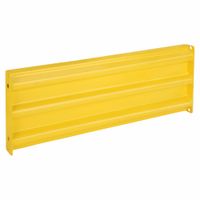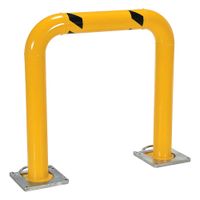Call +(254) 703 030 000 / 751 483 999 / 721 704 777
- Home
- Material Handling
- Guardrails Handrails Protectors
- Guardrails
.....Read More
Frequently Asked Questions
What are the benefits of using guardrails in industrial settings?
Guardrails in industrial settings offer several benefits, primarily focused on safety, efficiency, and compliance:
1. **Enhanced Safety**: Guardrails provide a physical barrier that prevents workers from accidentally stepping into hazardous areas, such as machinery zones, elevated platforms, or areas with moving vehicles. This significantly reduces the risk of falls, collisions, and other accidents.
2. **Accident Prevention**: By clearly delineating safe walkways and work areas, guardrails help in preventing accidents. They serve as a visual cue for workers to stay within designated zones, thereby minimizing the risk of entering dangerous areas.
3. **Protection of Equipment**: Guardrails can protect expensive machinery and equipment from accidental damage caused by forklifts, carts, or other moving equipment. This helps in reducing repair costs and downtime.
4. **Regulatory Compliance**: Many industrial settings are subject to strict safety regulations. Installing guardrails can help companies comply with OSHA and other safety standards, avoiding potential fines and legal issues.
5. **Improved Workflow**: By organizing space and defining pathways, guardrails can enhance the flow of operations. This can lead to increased productivity as workers and equipment can move more efficiently within the facility.
6. **Cost-Effectiveness**: While the initial investment in guardrails may seem significant, the long-term savings from reduced accidents, lower insurance premiums, and less equipment damage can make them a cost-effective safety solution.
7. **Employee Confidence**: A workplace that prioritizes safety through measures like guardrails can boost employee morale and confidence. Workers are likely to feel more secure and valued, which can lead to higher job satisfaction and retention rates.
8. **Versatility**: Guardrails can be customized and adapted to fit various industrial environments, making them a versatile safety solution for different types of facilities.
How do bolt-on guardrail systems differ from lift-out systems?
Bolt-on guardrail systems and lift-out systems are both used for fall protection, but they differ in design, installation, and application.
Bolt-on guardrail systems are permanently affixed to a structure. They are typically installed using bolts or screws, providing a secure and stable barrier. These systems are ideal for areas where long-term protection is needed, such as rooftops or platforms. The installation process requires tools and hardware, and once installed, they are not easily removed or adjusted. Bolt-on systems are known for their durability and strength, making them suitable for environments with high safety requirements.
Lift-out guardrail systems, on the other hand, are designed for temporary or flexible use. They consist of sections that can be easily lifted out and removed without the need for tools. This feature makes them ideal for areas where access is needed intermittently or where the layout frequently changes. Lift-out systems are often used in construction sites or warehouses where the configuration of the space may need to be altered. While they offer convenience and flexibility, they may not provide the same level of stability as bolt-on systems, especially in high-wind or high-traffic areas.
In summary, bolt-on guardrail systems are permanent, robust, and suitable for long-term applications, while lift-out systems offer flexibility and ease of removal for temporary or changing environments.
What are the installation requirements for highway-style guardrails?
The installation requirements for highway-style guardrails typically include the following key elements:
1. **Design Standards**: Guardrails must comply with national and local design standards, such as those set by the American Association of State Highway and Transportation Officials (AASHTO) or equivalent bodies in other countries. These standards dictate the type, height, and strength of the guardrails.
2. **Site Assessment**: A thorough site assessment is necessary to determine the appropriate type and placement of guardrails. Factors include road curvature, traffic volume, speed limits, and the presence of hazards like steep embankments or bodies of water.
3. **Material Specifications**: Guardrails are usually made from galvanized steel or other durable materials that can withstand environmental conditions and impacts. The materials must meet specific strength and durability criteria.
4. **Post Installation**: Posts are typically installed at regular intervals, often 6 to 12 feet apart, depending on the design requirements. They must be driven to a specified depth to ensure stability.
5. **End Treatments**: Proper end treatments or terminals are required to prevent the guardrail from becoming a hazard. These can include flared ends or energy-absorbing terminals designed to reduce the severity of impacts.
6. **Anchoring**: Guardrails must be securely anchored to the ground or a solid base to ensure they function correctly during a collision.
7. **Clear Zones**: Adequate clear zones must be maintained around the guardrails to allow for vehicle recovery and to minimize the risk of secondary collisions.
8. **Inspection and Maintenance**: Regular inspection and maintenance are required to ensure the guardrails remain effective. This includes checking for damage, corrosion, and ensuring that all components are securely fastened.
9. **Compliance with Environmental Regulations**: Installation must comply with environmental regulations to minimize impact on surrounding ecosystems.
10. **Safety Considerations**: Installation should prioritize the safety of both the workers and the public, adhering to occupational safety standards.
How do pipe-style guardrails protect machinery?
Pipe-style guardrails protect machinery by providing a physical barrier that prevents accidental contact or collision with the equipment. These guardrails are typically made from durable materials like steel or aluminum, ensuring they can withstand significant impact and environmental conditions.
1. **Barrier Protection**: They create a defined boundary around machinery, preventing unauthorized or accidental access. This is crucial in busy industrial environments where machinery is often in close proximity to human traffic.
2. **Impact Absorption**: The robust construction of pipe-style guardrails allows them to absorb and deflect impacts from vehicles, such as forklifts or carts, thereby protecting both the machinery and the vehicles from damage.
3. **Visibility**: Often painted in bright colors, these guardrails enhance visibility, alerting personnel to the presence of machinery and the need to maintain a safe distance.
4. **Safety Compliance**: Installing guardrails helps facilities comply with safety regulations and standards, reducing the risk of accidents and potential legal liabilities.
5. **Cost-Effective**: By preventing damage to machinery, guardrails reduce repair and maintenance costs, as well as downtime associated with equipment failure.
6. **Modular Design**: Many pipe-style guardrails are modular, allowing for easy installation, reconfiguration, or expansion as the layout of the facility changes.
7. **Psychological Barrier**: They serve as a psychological reminder for workers to stay clear of hazardous areas, reinforcing safety protocols.
Overall, pipe-style guardrails are a critical component of industrial safety, protecting both machinery and personnel by minimizing the risk of accidents and ensuring a safer working environment.
What materials are commonly used for guardrails?
Guardrails are essential safety features used to prevent vehicles from veering off roads and to protect pedestrians. Common materials used for guardrails include:
1. **Steel**: The most prevalent material, steel guardrails are known for their strength and durability. They are often galvanized to resist corrosion, making them suitable for various environmental conditions. Steel guardrails are typically used in highway and road applications.
2. **Wood**: Used primarily in rural or scenic areas to blend with the natural environment, wooden guardrails offer a more aesthetic appeal. They are less durable than steel and require regular maintenance to prevent decay and damage from weather conditions.
3. **Concrete**: Concrete barriers, such as Jersey barriers, are used in areas requiring high-impact resistance. They are durable and provide substantial protection but are less flexible than other materials, which can lead to more severe impacts in collisions.
4. **Cable**: Cable guardrails consist of steel cables tensioned between posts. They are designed to absorb impact energy and redirect vehicles. Cable systems are flexible and can be more forgiving in collisions, reducing the severity of accidents.
5. **Plastic and Composite Materials**: These are used for temporary or portable guardrails, often in construction zones. They are lightweight and easy to install and remove. Some composite materials are designed to mimic the appearance of wood or steel while offering enhanced durability and reduced maintenance.
6. **Aluminum**: Less common than steel, aluminum guardrails are lightweight and resistant to corrosion. They are used in areas where weight is a concern, such as bridges or elevated roadways.
Each material has its advantages and is chosen based on factors like location, environmental conditions, budget, and specific safety requirements.
How do guardrails improve safety in workplaces?
Guardrails significantly enhance workplace safety by providing physical barriers that prevent falls, guide movement, and delineate safe zones. They are crucial in environments with elevated platforms, open edges, or hazardous machinery. By acting as a physical barrier, guardrails prevent accidental falls from heights, which are a leading cause of workplace injuries and fatalities. This is particularly important in construction sites, warehouses, and manufacturing facilities where workers frequently operate at elevated levels.
Guardrails also serve as visual cues, guiding workers and visitors along safe pathways and away from dangerous areas. This is essential in busy environments where distractions are common, helping to maintain focus on safe practices. Additionally, guardrails can be used to demarcate restricted zones, ensuring that only authorized personnel access certain areas, thereby reducing the risk of accidents involving untrained individuals.
In industrial settings, guardrails protect workers from moving machinery and equipment. By creating a safe distance between personnel and operational hazards, they minimize the risk of contact injuries. Furthermore, guardrails can be integrated with other safety systems, such as warning signs and lighting, to enhance their effectiveness.
The presence of guardrails also contributes to a culture of safety within the workplace. They serve as a constant reminder of the importance of safety protocols and encourage compliance with safety regulations. This can lead to increased awareness and proactive behavior among employees, further reducing the likelihood of accidents.
Overall, guardrails are a fundamental component of workplace safety strategies, providing both physical protection and psychological assurance, thereby fostering a safer and more secure working environment.
What are the maintenance requirements for different types of guardrail systems?
Guardrail systems, essential for safety in various environments, require specific maintenance based on their type to ensure functionality and longevity.
1. **W-Beam Guardrails**: Regular inspections are crucial to check for damage from vehicle impacts, corrosion, or weathering. Damaged sections should be promptly replaced. Tighten loose bolts and ensure posts are firmly anchored. Repaint or apply anti-corrosion treatments as needed.
2. **Cable Guardrails**: Inspect tension levels regularly, as cables can loosen over time. Check for frayed or broken cables and replace them immediately. Ensure posts are stable and adjust tension to manufacturer specifications. Regularly inspect anchor points for signs of wear or damage.
3. **Concrete Barriers**: These require less frequent maintenance but should be inspected for cracks or chips that could compromise structural integrity. Repair any damage with appropriate concrete patching materials. Ensure that barriers are properly aligned and anchored.
4. **Wooden Guardrails**: Regularly inspect for rot, insect damage, or splintering. Replace any compromised sections. Treat wood with preservatives to prevent decay and maintain structural integrity. Check for loose nails or bolts and tighten as necessary.
5. **Steel Guardrails**: Inspect for rust, dents, or other damage. Apply rust inhibitors and repaint as needed to prevent corrosion. Ensure all connections are secure and replace any damaged sections promptly.
6. **Plastic or Composite Guardrails**: Check for UV damage, cracks, or warping. Clean regularly to prevent buildup of dirt and debris. Replace any damaged sections to maintain safety standards.
For all types, ensure that guardrails are free from obstructions and visible to drivers. Regular maintenance not only extends the life of the guardrail systems but also ensures they perform effectively in preventing accidents.



